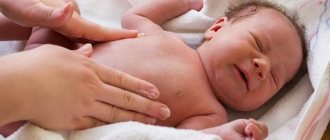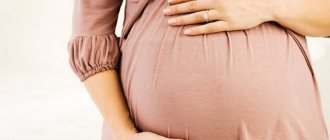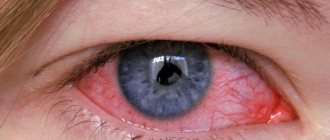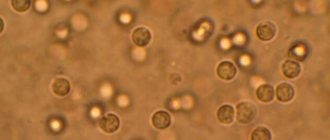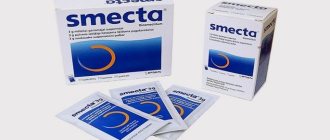Intestinal infection in children is a group of diseases of various etiologies that occur with primary damage to the digestive tract, toxic reaction and dehydration of the body.
Susceptibility to intestinal infection in children is several times higher than in adults; the disease is characterized by pronounced clinical signs and may be accompanied by weakened immunity, the development of enzyme deficiency, and intestinal dysbiosis. Intestinal infections in children occupy second place in the structure of infectious morbidity after acute respiratory viral infections.
The wide prevalence of intestinal infections among children is caused by the high contagiousness and prevalence of pathogens, their resistance to environmental factors, age-related characteristics of the structure and functioning of the digestive system, functional imperfections of protective mechanisms, as well as insufficiently instilled and reinforced hygiene skills.
In severe forms of intestinal toxicosis in children, pulmonary edema, acute renal and acute heart failure may develop. Approximately 2 million deaths from acute intestinal infections are recorded annually in the world, mainly among children under 5 years of age.
Causes
The cause of an intestinal infection in a child may be the only one - a pathological microbe has entered the baby’s body. The spectrum of pathogens is very wide.
These can be enterobacteria, including:
- Shigella.
- Salmonella.
- Campylobacter.
- Escherichia.
- Yersinia.
Representatives of opportunistic flora that can provoke the development of intestinal infection in a child are:
- Staphylococci.
- Proteus.
- Klebsiella.
- Clostridium, etc.
In approximately 70-80% of cases, the causative agents of intestinal infections are viruses:
- Rotaviruses
- Enteroviruses.
- Adenoviruses.
Less commonly, the disease is caused by lamblia, amoeba and coccidia - parasitic microorganisms, as well as fungi. However, regardless of the type of infectious agent, they all produce exo- and endotoxins and are enteropathogenic.
Pathogens can be transmitted by the fecal-oral route, nutritional route, water and household contact. If a child’s immunity is weakened, then even his own opportunistic flora living in the intestines can lead to the development of the disease.
Infected people or animals act as distributors of pathogenic flora. They release microbes into the external environment with feces, vomit, and urine. A person can remain contagious until he is completely healed, that is, until the clinical symptoms of the disease disappear. If a person is sick with a viral intestinal infection, then he can be a source of its spread even 2-3 weeks after complete recovery. Equally dangerous is consuming food and water containing germs.
The most common way of infecting a child with an intestinal infection is the fecal-oral and household route. In this case, the germs will be on household items, food or water. They get there if the rules of personal hygiene, sanitary standards, and food storage rules are not followed. A child swallows an infectious agent (licks hands, toys, eats contaminated foods, etc.), resulting in infection. Through the organs of the digestive system, microbes reach the intestines and begin to multiply there quickly.
It cannot be excluded that pathogens of intestinal infections may end up on various food products, even if the integrity of the packaging is maintained. Pathogenic flora multiplies if food has been stored for too long or the conditions for its storage are inadequate.
So, the main reason for the spread of intestinal infection among children is non-compliance with the rules of personal hygiene, which children, due to their age characteristics, are not able to learn 100%. Therefore, an adult is obliged to ensure that the baby does not come into contact with potentially dangerous household items or infected people, eat high-quality food and drink clean drinking water.
There are many types of intestinal pathogens. The table lists the main representatives of the pathogenic flora that cause the disease in childhood.
| Type of intestinal infection | How does it enter the child's body? |
| Bacteria; pathogens of intestinal infection in children | |
| Salmonella infection | Most often, salmonella enters a child’s body after eating contaminated eggs, milk, butter and meat. Sources of infection can be not only people, but also pets. The disease is difficult for children aged 2-3 years. They are at high risk of developing toxic shock with kidney and heart failure and cerebral edema. |
| Staphylococcal infection | Staphylococci exist in the body of all people, but there are so few of them that they are not capable of leading to the development of disease. When a child’s immunity is weakened, staphylococci can begin to multiply rapidly, causing an intestinal infection. Also, a child can swallow an impressive amount of staphylococci along with food when eating stale foods. |
| Shigellosis or dysentery | The source of infection is a sick person who has a mild or mild course of the disease. Children will be contagious from the first day of illness; Shigella is excreted in the feces. The mechanism of transmission of infection is fecal-oral, and the route of transmission is water, food, contact and household. Shigella can enter a child’s body through expired foods, unwashed vegetables and fruits, and by ingesting water in swimming pools and open reservoirs. |
| Escherichiosis or coli infections | The causative agent of the disease is Escherichia coli. The source of infection is a healthy or sick person. Infection can also occur through water (this happens rarely) and through food when a child eats dairy products, meat dishes, compotes, kvass, and salads with boiled vegetables. Children often become infected through contaminated hands, toys, and door handles. |
| Viruses are causative agents of intestinal infection in children | |
| Rotaviruses | The source of rotavirus infection is a sick person. The transmission mechanism is fecal-oral, which can be realized through food, water, and household contacts. Rotavirus infection is widespread among children, which is why it is even called childhood intestinal flu. |
| Enteroviruses | The sources of infection are adults and children who are infected with enteroviruses. Transmission of infection occurs not only through the fecal-oral route, but also through airborne droplets. Most often, enterovirus infection affects children aged 3-10 years. |
| Adenoviruses | The source of adenovirus spread is a sick person. Infection most often occurs by airborne droplets; viruses are released into the external environment with nasopharyngeal secretions. However, the fecal-oral and contact-household route of transmission cannot be excluded. To date, more than 50 adenoviruses have been identified that can lead to intestinal infection. |
How do infants become infected with intestinal infections?
The most common source of infection for infants is adults who suffer from acute intestinal infections or are carriers of pathogenic objects. The incubation period for ACI is usually short, with the exception of some pathogens, and lasts from several hours to several days (usually 1-2 days). For viral infections, contagiousness can last throughout the period of clinical symptoms and even up to two weeks after all symptoms have disappeared. In addition, food and water can be sources of pathogens for infants who are infected with viruses or microbes of a dangerous group.
note
The causative agents of acute intestinal infections enter the body through the mouth - from dirty hands, with food or water, and for some infections the airborne route is also relevant (as with ARVI). Household appliances, dishes and things that are contaminated with pathogenic viruses and microbes can also be sources of infection. Bathing water taken from open reservoirs, which gets into the mouth, as well as non-observance of personal hygiene by parents, especially if they themselves are sick or are carriers of infection, can become dangerous.
Infants are the most susceptible to OCI, although people of any age can suffer from it. For children, a more severe course is typical, with a rapid onset of dehydration and negative consequences in the form of seizures, dehydration or other complications. For infancy, there are certain risk factors that lead to a more severe course of acute intestinal infections:
- Formula feeding from birth
- Children with prematurity or immaturity
- Introduction of complementary foods that are inappropriate for age, improperly prepared, and contaminated with pathogens
- Summer period, when the activity of dangerous pathogens is higher (for microbes)
- Cold season (for viruses)
- Immunodeficiency conditions of congenital or acquired origin
- Lesions of the nervous system of traumatic or hypoxic origin.
It is important to understand that immunity to these infections is extremely unstable, and infants can, having had one acute infection, subsequently become infected with other types if precautions are not taken.
Symptoms of intestinal infection in children
Clinical symptoms of intestinal infections in children are associated with the destruction of cells of the intestinal mucosa, as well as digestive disorders and are manifested by two syndromes: intestinal and infectious-toxic (general intoxication syndrome).
The severity of intestinal infection in children is largely determined by the amount of fluid loss.
The main symptom of any form of intestinal infection is diarrhea (repeated loose stools).
Other signs:
- nausea, vomiting;
- lethargy, weakness;
- loss of appetite;
- increased body temperature;
- pain, rumbling in the stomach;
- blood in the stool;
- breathing problems;
- weight loss.
The danger is dehydration, which develops as a result of fluid loss through copious amounts of vomit and feces. Its signs:
- sunken fontanelle in an infant;
- dry skin and mucous membranes;
- decreased diuresis;
- increased thirst;
- sunken, dry eyes;
The clinical picture of some intestinal infections has its own characteristics.
Dysentery in children is characterized by general intoxication, fever, vomiting, dysfunction of the central nervous system, cardiovascular system and colitis syndrome (dull abdominal pain, diarrhea, the presence of mucus and blood in the stool, spasm of the sigmoid colon, pain in the rectum).
Rotavirus infection is highly contagious, the clinical picture is manifested by gastroenteritis, damage to the gastrointestinal tract is combined with catarrhal symptoms (rhinitis, hyperemia of the pharynx, coughing, sore throat).
The symptoms of salmonellosis depend on the form of the disease. The typical (gastrointestinal) form is most common and can occur in the form of gastritis, pancreatitis, enteritis, appendicitis, pyelonephritis, cholecystitis, gastroenterocolitis. The stool is liquid, copious, brown-green in color, mixed with mucus and blood. The atypical form can have a septic, typhus-like, toxic-septic (in newborns), erased and asymptomatic course.
Detection of an intestinal infection in children under five years of age is grounds for hospitalization in the children's infectious diseases department of the hospital.
Escherichiosis mainly affects young children who are bottle-fed. The disease has a gradual onset with diarrhea, vomiting or regurgitation over the next three to five days. Body temperature is subfebrile or normal. The stool is watery, yellow-orange in color, mixed with mucus. Symptoms of the disease increase over 3-5 days. The disease can occur in three clinical variants (cholera-like syndrome, mild enteritis that occurs against the background of acute respiratory infections in young children, and foodborne toxic infection).
Staphylococcal intestinal infection in children can be primary or secondary. The course of the primary infection is characterized by diarrhea, toxicosis, and vomiting. The stool is watery, mixed with mucus, greenish in color. With secondary staphylococcal infection, intestinal symptoms develop against the background of the underlying disease (pneumonia, tonsillitis, purulent otitis, staphyloderma, etc.).
Types of pathogens
In children, most often intestinal infections are bacterial or viral in nature.
The most common such infections are rotavirus, better known among the population as intestinal flu, shigellosis or dysentery. Salmonella, Escherichia, Yersinia, staphylococcus, etc. can also be causative agents of pathology.
Often, in infants, the causative agents of acute intestinal infections are opportunistic microorganisms that belong to the normal flora, but under some circumstances provoke infectious lesions.
Such circumstances include immaturity of the immune defense, taking antibacterial drugs, etc.
Complications
If therapy is carried out incorrectly/untimely, dehydration of the body, disruption of the normal functioning of internal organs, intestinal dysbiosis, and a decrease in the defense of the immune system may occur. Severe pathology leads to the following complications:
- neurotoxicosis – the patient experiences a disorder of consciousness, sleep disturbance, hallucinations and convulsions are possible;
- circulatory disorder - blood pressure decreases, the skin becomes pale, problems of the cardiovascular system develop;
- renal failure - scanty urine output, dull pain in the lower back;
- hypovolemic shock – develops due to dehydration, sunken eyes, weight loss.
Diagnostics
If a child exhibits signs of OCI, parents should immediately seek help from a specialist so as not to worsen the condition.
The pediatrician conducts a patient interview, visual and tactile examination. This is enough to establish a correct diagnosis and prescribe treatment. In order to identify the causative agent of the disease, the following diagnostic studies are carried out:
- bacteriological culture of vomit and feces;
- scraping from the anus;
- coprogram (analysis of feces);
- laboratory blood test for TA.
Intestinal infection - treatment
The most important rule in the modern treatment of any intestinal infection is to prevent dehydration and follow a diet.
Taking any medications is not necessary and, moreover, in 90% of cases of intestinal infections, it is not necessary, since the human body itself can destroy pathogenic microbes (as in the case of acute respiratory viral infections or colds), and it just needs to “hold out” until the immune system produces a sufficient number of antibodies that can have a detrimental effect on a specific microorganism that has entered the intestines. In other words, the human body can cope with almost any intestinal infection on its own, so it does not need medications to treat it, but only needs measures to ensure the maintenance of normal functioning of organs and systems. And such measures are drinking plenty of fluids and dieting.
Thus, drinking plenty of fluids replenishes the loss of fluid that occurs along with diarrhea and vomit, and the diet minimizes the load on the intestines, as a result of which the cells of its mucous membrane can be restored as quickly as possible. Under such conditions, the patient’s own immune system successfully copes with the infection in 3 to 8 days.
Replenishing fluid and salt losses (drinking plenty of fluids) is called rehydration therapy. In order for the body to receive not only water, but also salts lost through diarrhea and vomiting, you need to drink special rehydration solutions sold in pharmacies. Currently, the most effective rehydration solutions are the following:
- Gastrolit;
- Hydrovit;
- Glucosolan;
- Maratonic;
- Orasan;
- Register;
- Regidron;
- Reosolan;
- Humana Electrolyte;
- Citraglucosolan.
These rehydration drugs are sold in powders, which are diluted with ordinary clean drinking water, after which they are drunk as a means of replenishing the volume of water and salts lost by the body through vomiting and diarrhea. However, if it is impossible to buy a rehydration solution for any reason, you should prepare it yourself. According to WHO recommendations, to obtain the optimal composition of a rehydration solution, you need to dissolve a tablespoon of sugar, a teaspoon of salt and a teaspoon of baking soda in one liter of water. As a last resort, when for some reason it is impossible to even prepare a rehydration solution yourself, you should drink various liquids containing salts, such as tea with sugar, compote, fruit juice, still mineral water, etc. It must be remembered that in case of an intestinal infection it is better to drink at least something than nothing.
The amount of rehydration solution that you need to drink during an intestinal infection is determined simply based on the ratio of 300 - 500 ml of solution for each episode of loose stools or vomiting.
Rehydration solutions should be drunk slowly, in small, frequent sips, so as not to provoke vomiting. In this case, the entire volume of the solution (300-500 ml) does not need to be drunk at one time - it is optimal to drink 100-150 ml every 5-15 minutes. It is advisable to heat the rehydration solution to a temperature of 36-37oC, since in this case liquid and salts are most quickly absorbed from the stomach into the blood and replenish losses.
During the entire period that there is loose stool or vomiting, the adult or child should be closely monitored for signs of dehydration. Signs of dehydration include the following symptoms:
- No urine for 6 hours;
- A child's crying without tears;
- Dry skin and mucous membranes;
- Dry tongue;
- Sunken eyes;
- Sunken fontanel (in infants);
- Grayish skin tone.
If a child or adult shows signs of dehydration, you should immediately call an ambulance and be hospitalized in a hospital where intensive rehydration therapy will be carried out. In a hospital setting, rehydration therapy is carried out by intravenous administration of salt solutions. You should not try to treat dehydration yourself at home, since this condition is very dangerous due to the high likelihood of developing shock, followed by possible death. It is because of the risk of death that dehydration can only be treated in hospital.
Hospitalization to a hospital for an intestinal infection should also be carried out when a person exhibits the following signs (in addition to signs of dehydration):
- Blood in the stool;
- The diarrhea stopped, but the vomiting increased, or after the temperature dropped, it increased again, or abdominal pain appeared;
- Inability to drink rehydration solutions due to persistent vomiting;
- Severe weakness and thirst;
- The patient's age is less than one year or older than 65 years.
In all other cases, treatment of intestinal infection can be carried out at home.
In addition to rehydration therapy, in case of intestinal infection, it is imperative to follow diet No. 4. Until diarrhea and vomiting stop, you can only eat slimy soups (cereal soups), weak broths, boiled pureed lean meat, boiled lean fish, scrambled eggs, boiled porridge, stale white bread, crackers, unhealthy cookies, baked apples without skin. Completely exclude from the diet milk and dairy products, smoked meats, canned food, spicy, spicy, fatty and fried foods, onions, garlic, radishes, alcohol and carbonated drinks. After diarrhea stops, you should eat dietary foods for another 3 to 4 weeks, avoiding carbonated drinks, alcohol, milk, fatty, fried and smoked foods. Complete restoration of the intestinal digestive ability after an infection occurs only after 3 months.
Taking antibiotics, sorbents, probiotics, antipyretics and other medications is not at all necessary to treat any intestinal infection, and in some situations it is even harmful. So, antibiotics for intestinal infections should be taken only in the following three cases:
- Severe cholera;
- Blood in the stool;
- Prolonged diarrhea due to giardiasis.
In all other situations, there is no need to take antibiotics for an intestinal infection, since they will not be beneficial and will not speed up recovery, but will only destroy the remnants of the intestinal’s own normal microflora.
Painkillers should not be taken for intestinal infections, since increased spasms and pain are a signal of the development of complications that require urgent hospitalization. And if a person takes painkillers, he simply will not feel an increase in spasms and will miss the moment when complications begin to develop. Complications of an intestinal infection can lead to serious consequences, even death.
Sorbents and probiotics for any intestinal infection can be taken as desired. The high effectiveness of these drugs has not been proven, but a number of doctors and scientists believe that these drugs are useful for treating intestinal infections. And since probiotics and sorbents do not cause harm, they can be used as desired. In other words, if a person wants or considers it necessary to take sorbents and probiotics to treat an intestinal infection, then he can do so.
Antipyretic drugs are the only drugs that are recommended to be taken for intestinal infections if the body temperature is above 37.5oC. High temperatures accelerate the loss of fluid by the body, because the skin is cooled by the evaporation of moisture. Accordingly, to reduce fluid loss, you need to reduce your body temperature, for which you should take antipyretic drugs. Preparations with paracetamol, ibuprofen and nimesulide are optimal for reducing body temperature.
No other medications are used for intestinal infections.
Thus, to summarize, we can say that the treatment of intestinal infection consists of mandatory rehydration therapy (replenishment of fluid loss) and diet. In addition to diet and drinking plenty of saline solutions, the following medications can be used additionally (at the request of the patient) to treat intestinal infections:
- Sorbents (Polysorb, Polyphepan, Smecta, etc.);
- Probiotics (Enterol, Bactisubtil);
- Intestinal antiseptics (Enterofuril, Intetrix, etc.);
- Enzymes (Pancreatin, Mezim, Creon, Panzinorm, etc.);
- Antipyretics with paracetamol, ibuprofen or nimesulide;
- Antibiotics only when indicated (see above).
In addition, we should separately highlight activities and actions that absolutely cannot be performed if an intestinal infection is suspected:
- Take painkillers - they can mask the pain, which will hinder the timely detection of complications.
- You should not take antiemetics (Cerucal, Metoclopramide, etc.) or fixatives (Loperamide, Imodium, etc.), since diarrhea and vomiting are necessary to remove toxic substances from the body. If you stop diarrhea and vomiting with medication, then toxic substances will accumulate in the body, which will significantly worsen the patient’s condition, slow down recovery and increase the risk of complications.
- You cannot do an enema yourself, especially with warm or hot water.
- You should not warm your stomach - heat will only intensify the inflammatory process and aggravate the course of the infection.
Features of lesions in different parts of the digestive tract
Depending on which part of the digestive system is more affected, the severity of the symptoms and their specific manifestations will depend. Predominant infection of the stomach leads to the clinical picture of acute gastritis in infants. It can be manifested by nausea and vomiting, in infants it can be a fountain, as well as copious regurgitation immediately after eating food and water. There may also be pain in the stomach, which in the baby manifests itself in screams and inconsolable crying, which subsides for a while after vomiting. The stool may be slightly loose, but only for a short period of time. Due to frequent and repeated vomiting, dehydration can quickly occur. Such isolated lesions of the stomach alone are uncommon.
Damage to both the stomach and small intestine forms acute gastroenteritis, which leads to abdominal pain localized near the navel, and in infants spread throughout the abdomen and manifested by screaming and crying, tucking in the legs. Against this background, frequent loose stools occur, which at first have a mushy appearance, then turning into watery. Based on the reasons, there may be color changes with greenish or brownish tints, and there may also be undigested particles of food or milk, mixture. Against the background of problems with stool, there are also all the above-described manifestations of gastritis.
Isolated enteritis occurs without vomiting or with single vomiting, which occurs against the background of abdominal pain. But for enteritis, repeated profuse, watery stools are typical, and its frequency depends on the type of pathogen, the amount of the agent ingested and the severity of the condition. This condition is also dangerous due to dehydration due to large losses of fluid in the stool.
Manifestations of gastroenterocolitis are simultaneous damage to both the stomach and all parts of the intestine, both small and large . Typical for him are regurgitation, nausea with vomiting, repeated, as well as frequent loose stools and abdominal pain, which spread to all departments. Defecation brings pain to the baby; often a lot of mucus and blood are found in the stool; some of the bowel movements may be scanty and slimy.
Enterocolitis leads to the development of pain throughout the abdomen, loose stools, as well as periodic scanty bowel movements with mucous discharge and blood streaks . Colitis is characterized by the appearance of pain in the lower abdomen, especially the lateral part of the abdomen, defecation brings pain, stools are light and with mucus, false urge to defecate and bloating, flatulence are frequent.
Depending on the pathogen, certain parts of the digestive system are predominantly affected:
- Acute gastritis often occurs due to foodborne infections and poisonings,
- Gastroenteritis is typical for salmonellosis, escherichiosis, staphylococcal infection, and rotavirus.
- Enteritis most often occurs with cholera,
- Enterocolitis or colitis occurs with microbial dysentery.
At an early age, manifestations of gastroenteritis or gastroenterocolitis often occur; isolated and localized lesions of the digestive system rarely occur.
Drug treatment
Currently, the following groups of drugs can be used for intestinal infections:
- Antipyretics containing paracetamol, ibuprofen or nimesulide. Antipyretics are recommended to be taken at body temperatures above 37.5oC, since normalizing body temperature will minimize the loss of fluid and salts by the body. These medications are taken as needed.
- Rehydration solutions (Regidron, Trisol, Glucosolan, Orasan, Humana Electrolyte, etc.). They are taken without fail until the end of diarrhea and vomiting in order to replenish the volume of lost fluid and salts to prevent dehydration.
- Enterosorbents (Polyphepan, Polysorb, Enterosgel, Smecta, Laktofiltrum, Filtrum, Activated carbon, White carbon, etc.). Taken until the end of diarrhea and vomiting at the request of the patient. Enterosorbents do not speed up recovery, but provide subjectively better health to the patient.
- Intestinal antiseptics (Intetrix, Enterol, Entero-sediv, Intestopan, Enterofuril, Furazolidone, etc.). Take at the request of the patient until the end of diarrhea and vomiting. Helps destroy pathogenic microbes that cause intestinal infection.
- Probiotics (Bactisubtil, Enterol, Linex, etc.). They are taken at the request of the patient, as they help destroy pathogenic microbes and restore intestinal microflora.
- Enzymes (Micrazim, Mezim, Creon, Panzinorm, etc.). Taken at the request of the patient, they promote digestion and absorption of food.
- Antibiotics (Levomycetin, Tetracycline, etc.). Accepted only according to indications!
How to feed and what
We have already found out that the key to successful treatment of an intestinal infection is for the baby to drink a lot of fluids.
Moreover, this is exactly the case when the main thing is quantity, not quality. Therefore, if a child agrees to drink only sweet juice or soda, let him drink even that. It is optimal, of course, to try to pour the harmful drink into the child at least a little diluted (for example, 3 to 1 or 2 to 1 with water), but if absolutely nothing, then you don’t have to dilute it.
All you have to do is monitor whether your child has enough fluid. Here, the easiest way to determine whether your toddler drinks enough is to track the frequency, volume and color of urination. The child should walk a little every 1 - 2 hours, and more often. The urine should be light in color.
If the intervals are longer, this is a reason to increase the amount of fluid you drink. So, if the baby drinks and urinates often enough (every 1-2 hours or more often), everything is under control.
Now let's talk about those situations when a baby (like my Eva) refuses to drink, spits and cries. How to get drunk in this case? We'll have to help the little one drink. And since we will still be doing this forcibly, it is more rational to use special solutions for oral rehydration (for example, Regidron), which can quickly and effectively replenish the deficiency of fluid and essential salts in the baby’s body.
If you don’t have a ready-made sachet on hand, you can prepare an analogue of such a solution at home yourself from available products.
Oral rehydration solution recipe:
- liter of bottled or boiled water;
- 2 tablespoons sugar;
- 1 teaspoon salt;
- 1 teaspoon of soda.
It is best if the solution is at body temperature, that is, 36-37 degrees. This will allow the liquid to be absorbed from the stomach faster and not cause vomiting.
Since the baby spits out the pacifier and bottle, we will use other items. A special plastic dispenser, which comes complete with antipyretic children's syrups (Panadol, Nurofen), is very convenient for use. But if you don’t have one at hand, a regular syringe (without a needle, of course) will do just fine.
So, we stocked up with everything necessary to replenish fluid reserves in the body of a baby who refuses to drink, the procedure will be as follows.
- Prepare oral rehydration solution.
- We put it into a plastic dispenser or syringe (without a needle).
- We take the baby in our arms or place him on another surface so that it is comfortable for us and his head is higher than his body.
- We take the liquid into a plastic dispenser or syringe (without a needle) and begin to slowly, literally drop by drop, drop the solution onto the baby’s cheek.
- We make sure that he swallows and does not choke. We calculate the amount of fluid based on the child’s age and stomach volume from 20 ml at the age of 1 month to 80 ml at the age of 1 year. Repeat the procedure every 1 hour.
Get ready for crying, screaming, scandals, but how could it be otherwise? During the first 24 hours, I poured this solution into Eva at night.
Of course, living with round-the-clock infusion of saline solution into a baby, although vital, is difficult. Therefore, I recommend not to stop trying to offer various sweet drinks (compote, fruit drink, diluted juice, sweet tea, etc.). By the way, it is in this direction that you can direct the excess energy of advisers (grandmothers and other relatives) who strive to feed a sick child and stuff him with unnecessary medications.
It is possible that a child who initially refuses to drink will begin to enjoy drinking sugary drinks after saline.
This is exactly what happened with us. That is, at first I poured the solution from a syringe, because Eva refused even sweet juice (diluted 1 to 1 with water), but then after a couple of such infusions she began to happily absorb the same juice from the bottle that I offered her every time .
This allowed me, over time, to completely abandon the infusion of saline solution, because the liquid I voluntarily drank became enough, and the drinking regime was established.
My reward was the complete recovery of my baby on the third day without antibiotics, IVs or hospitals. This is exactly how it will all end in 90 percent of cases if you follow all the recommendations.
The photo below shows absolutely the entire arsenal of remedies that we used to treat intestinal infections, nothing more! Three days later we swam in the sea again, and after five we ate with excellent appetite.
Use of antibiotics
Antimicrobial therapy for intestinal infections is used only in extreme cases. Usually, basic therapeutic methods are sufficient to completely eliminate the disease. You cannot voluntarily give your child medications from this group without the consent of the doctor.
Antibiotics have a detrimental effect on the intestinal microflora, and in most cases their consumption is completely pointless and ineffective. The World Health Organization has approved a list of pathological conditions for which it is allowed to prescribe an antibacterial agent:
- hemocolitis (presence of blood in vomit and feces);
- severe types of cholera;
- persistent diarrhea (including with giardiasis).
Nutrition and diet for intestinal infections
Diet for intestinal infections in children is a mandatory method of therapy, allowing to restore impaired functions of the digestive system and speed up the recovery process. Many parents are interested in what to feed their child with an intestinal infection.
For the first day after infection, it is better for the baby not to eat anything at all. If the child develops an appetite, he can be given rice water; older children can be given crackers.
The diet menu for intestinal infections in children should consist of easily digestible and pureed food. Products such as whole milk, brown bread, fermented baked milk, yoghurt, cream, porridge with milk, beets, legumes, citrus fruits, meat and fish broths, fatty meats, poultry and fish are prohibited for consumption.
The menu for intestinal infections in children should be based on foods such as porridge with water - corn, rice, buckwheat, and lean meat - turkey, chicken breast, veal, rabbit meat. Then fermented milk products are gradually introduced into the diet; vegetables and fruits can be eaten after the unpleasant symptoms of digestive system disorders have disappeared. It is recommended to feed the child with rosehip infusion, weak tea, rice infusion, dried fruit compote, but without prunes.
The menu might look something like this:
- Breakfast – semolina porridge cooked in water, a glass of unsweetened tea.
- Snack – steamed soufflé made from homemade low-fat cottage cheese.
- Lunch – light broth from lean chicken, steamed veal meatballs, fruit jelly.
- Afternoon snack – 200 g of rosehip decoction, rye bread crackers.
- Dinner – low-fat steamed fish, unsweetened tea.
- Before bed, you can give your child a glass of low-fat homemade yogurt.
A variety of diet recipes for children after an intestinal infection will allow parents to avoid problems with choosing suitable dishes for the child’s still weakened body.
Steamed chicken soufflé
To prepare a dish according to this recipe for intestinal infections in children, you will need boiled chicken breast, egg, 4 tbsp. l. chicken broth, 1 tbsp. l. flour. Follow this sequence for preparing soufflé after an intestinal infection for a child using this recipe:
Pass the boiled chicken breast through a meat grinder;
- combine chopped chicken meat with egg yolk, beaten white, add a spoonful of flour, salt and mix;
- Mix the mixture thoroughly, place it in a mold greased with vegetable oil and steam.
Slimy soup
To prepare mucus soup, use this recipe for this dish for intestinal infections in children:
- Place a saucepan with 2 liters of water on the fire and add ½ cup of washed oatmeal.
- Finely chop the onion and carrots, add to the soup, add a little salt, boil for another 15 minutes and remove from the stove.
- When the soup has cooled slightly, rub it through a sieve; if desired, you can add a spoonful of vegetable oil.
Blueberry jelly
You can use this dietary recipe for children with intestinal infections to prepare blueberry jelly:
- Rinse 2/3 cup of blueberries with running water.
- Pour 4 cups of water into a saucepan, put on fire, and bring to a boil.
- Add 2 tbsp. l. Sahara. Stir 1 tbsp in a glass of cold water. l. starch, gradually pour into sugar syrup.
- Place washed blueberries in a saucepan and stir.
- Reduce heat, bring to a boil and remove from heat.
Vegetable salad
At the end of the course of the disease, when the symptoms of intestinal infection begin to gradually disappear, fresh vegetables can be introduced into the child’s diet. If you don’t know what to cook for your child with an intestinal infection, this recipe will diversify your baby’s diet menu:
- Boil carrots, cauliflower and zucchini.
- Cut all the vegetables into small cubes, add a little salt, mix well, season with 1 tbsp. olive oil.
Treatment at home - medications
To treat rotavirus infection, sorbents are prescribed that remove all toxic substances from the body. It is also very important to give your baby rehydrating and antimicrobial drugs. Often, specialists prescribe such medications.
Antimicrobial
- Furazolidone
Action: helps restore immunity and kill pathogenic microorganisms. It normalizes the body's microflora and stimulates the production of leukocytes in the blood. The drug is prescribed for prolonged diarrhea.
This is interesting: Chronic cholecystitis. Treatment, drugs, symptoms, recommendations
Dosage and method of use: fifty gram capsules are often prescribed to dilute the suspension. For better absorption into the body, the drug is taken after meals . A single dosage is calculated according to the baby’s weight: per 1 kg – 10 ml of medicine.
Furazolidone is used in tablet form only by children over five years of age, 20-50 ml at a time. The course is 10 days. The drug is strictly prohibited for children under one year of age.
It is important to know! Combining Furazolidone with other drugs can cause inhibition of hematopoietic function.
- Stopdiar
Action: the drug neutralizes the harmful effects of rotavirus on the child’s body. With its regular use, bacteria lose their ability to reproduce.
Directions for use: shake the bottle with the substance until it becomes a homogeneous consistency. Take a measuring spoon and pour the required amount: infants - 1-2 spoons of 2.5 ml twice a day; for schoolchildren and teenagers - 1 spoon of 5 ml three times a day. The course of medication is a week.
Antiviral agents
- Cycloferon
Action: has an immunostimulating effect, kills infection and relieves inflammation.
Method of administration and dosage: Cycloferon is used in complex therapy and perfectly enhances the effect of other drugs. Take 2 tablets every other day. The course is 14-20 days.
- Ingavirin
Action: relieves symptoms of the disease, accelerates the healing process. Directions for use and dosage: prescribed to children over 7 years old, 60 mg once a day. The course of treatment is a week. It is recommended to use the drug in the first days of symptoms.
Side effects: allergic reaction, nausea and vomiting. Contraindications: individual sensitivity to the components of the drug.
- Amiksin
Action: effectively suppresses the multiplication of the virus inside cells, which speeds up the healing process. Doses and method of administration: the drug is used only by children over 7 years of age. 60 mg once a day after meals.
Contraindications: allergy to the components of the drug. To check for an allergic reaction, you need to give one tablet of the drug to a child and observe his body’s reaction. If a rash appears, stop using the drug. It is also prohibited to use the drug if there is mental or physical developmental delay.
Side effects: constipation or diarrhea, heaviness in the stomach, bloating, nausea, chills.
- Kagocel
Action: destroys viruses and normalizes microflora.
Doses and method of administration: children from 3 to 6 in the first two days should take 1 tablet 2 times a day, and in the next 2 days the amount of the drug should be reduced to 1 tablet 1 time a day. Children over 6 years old are recommended to take 1 tablet 3 times a day in the first two days, and then 1 tablet 2 times a day. The course of treatment is 4 days.
Contraindications: allergic reaction, children under 3 years of age, lactose intolerance. Side effects: a red rash on the body, accompanied by severe itching; in rare cases, Quincke's edema occurs.
Sorbents
- Polysorb
Action: binds toxic substances and removes them from the body.
Directions for use and dosage: per 10 kg child, give 0.5-1.5 teaspoons. If vomiting or diarrhea is present, the child is given up to 4 spoons per half glass at once. In the absence of dyspeptic symptoms, Polysorb is taken five times on the first day in equal doses. Already after 10-15 minutes after taking the drug, the child feels relief of symptoms.
The antipyretic can be given to the baby no earlier than an hour after using the drug.
- Smecta
Action: removes toxins from the body. Directions for use and doses: the drug must be taken before antipyretic and immunostimulating drugs, as it will remove them from the body.
Babies under one year old are recommended to consume up to 2 sachets per day. Children over one year old - up to 4 sachets. The powder should be diluted in warm water to form a suspension and drunk.
Contraindications: constipation (taking the drug can lead to constipation, so intestinal blockage is the main contraindication), vomiting, fever, lack of effectiveness of drug treatment, allergic reaction.
- Enterosgel
Action: neutralizes toxic substances and pathogenic microorganisms. It has selective activity and does not remove nutrients and microelements. Perfectly eliminates diarrhea and alleviates the symptoms of intoxication of the body.
Dosage: infants are given a teaspoon of enterosgel 3 times a day, and older children need to take a tablespoon 3 times a day. If a child refuses to take the medicine, then it can easily be added to juice or jelly, as this will not lose its effectiveness. Side effects: dyspepsia, constipation.
Probiotics
- Bio Guy
Action: supports and protects intestinal microflora, participates in digestive processes, normalizes stool.
Doses and method of administration: for children under three years of age, take 5 drops diluted in water or milk, 1-2 times a day. Contraindications: allergic reaction.
- Lactulose
Action: lactulose changes the intestinal microflora, increasing acidity and stimulating peristalsis. Increases the amount of feces and inhibits the growth of bacteria.
This is interesting: Genetic analysis for predisposition to diseases. What is it, who is it for, price
Directions for use and dosage: the drug is used by children over 7 years of age. The dose is 10-15 ml of syrup once a day with meals. Side effects: bloating, nausea, vomiting, lack of appetite, diarrhea.
- Inulin
Action: promotes the growth of beneficial microflora. Directions for use and dosage: dissolve the powder in a glass of water and drink with meals. It is recommended to use the drug 1-3 times a day.
Side effects: the drug is non-toxic, combines well with other drugs and does not cause side effects even with long-term use.
Rehydrating solutions
- Regidron
Action: restores and maintains water-alkaline balance, eliminates diarrhea and prevents blood pH disorders.
Directions for use and dosage: dissolve the contents of the sachet in a liter of boiled water. Drink 10 ml per kilogram of body weight per hour. After relief of symptoms, the drug is reduced to 5-10 ml per kg of body weight.
- Regidron bio
Action: normalizes water balance, eliminates diarrhea and vomiting, improves well-being.
Directions for use: dilute the sachet in a liter of boiled water and take orally. It is necessary to drink the medicine during the day, as then it will lose its beneficial properties.
It is highly not recommended to mix rehydron with other components or drugs, as it can only aggravate the course of the disease.
- Bio Gaia Protexis
Action: improves immunity, normalizes intestinal microflora.
Directions for use: only children over 3 years old can take 1-2 tablets per day. The tablet should be chewed.
Antipyretics
An elevated temperature can only be brought down if it reaches 38 degrees or more. It is best to use Cefekon suppositories, as they can lower the temperature even during sleep. If the temperature does not go down, then you need to give the baby Paracetamol with 1/4 Analgin.
Paracetamol can be given 2-3 hours after taking another antipyretic drug, and Nurofen only after 4.
You can also use rubbing to lower the temperature, but it is very important to wipe the entire body, open and remove the diaper from the baby. Enterofuril is effective for lowering temperature. To prevent bacterial infection, it is used for 5 days.
Forecast
With most etiological variants of intestinal infection in children, a favorable course of clinical symptoms and a tendency to complete recovery are observed in short periods of time. The prognosis for the child’s recovery and restoration of intestinal function is influenced not only by the use of drug treatments, but also by compliance with the water-drinking regime and a special menu for intestinal infections in children. When therapeutic measures are not applied in full or the treatment regimen is not pathogenetically justified, an unfavorable prognosis of the disease may be observed in the form of the development of chronicity of pathological processes in the intestines and the development of bacterial carriage.
A feature of the course of intestinal infection in children is the tendency in 25% of cases to develop pathology of the digestive tract in the form of enzymatic deficiency, biliary tract dysfunction, the development of intestinal dysbiosis, as well as functional dyspepsia.
In the case of a complicated course of intestinal infection, both complete recovery and death can be observed, therefore, when the first signs of complications develop, it is necessary to begin emergency drug correction. The most common variant of the complicated course of intestinal infection in children is the development of dehydration syndrome, which can occur in varying degrees of severity, which determines the prognosis for recovery. The extreme degree of dehydration of a child’s body due to intestinal infection is the development of dehydration shock, which has a high mortality rate.
In a situation where the development of an intestinal infection in a child is associated with the activation of a pathogenic viral infection, there is a risk of developing infectious-toxic shock, which is an extremely unfavorable clinical prognostic marker. A relatively rare complicated variant of intestinal infection in children is uremic, in which clinical and laboratory signs of renal failure are observed, which are quickly relieved by taking medications.
Treatment of newborns
Treatment of intestinal infections in breastfed infants is much faster and easier than in formula-fed infants. After all, breast milk strengthens the immune defense and increases the body's resistance to pathogenic microorganisms.
The primary task is to cleanse the intestinal structures of pathogenic pathogens, which helps stop the toxic effects and prevent dehydration. Such small children must be treated under strict medical supervision, then the microclimate in the intestines will quickly return to normal.
It is important to exclude food for 12-18 hours, during which it is allowed to give the baby water or weak tea.
The use of sorbent agents (Enterosgel, Smecta) is indicated, which help to quickly remove all toxic substances from the structures of the gastrointestinal tract and contribute to the rapid restoration of water-electrolyte balance.
If the baby often vomits, then you need to rinse the stomach cavity. If the baby still vomits, then you need to provide drip-infusion nutrition to the child. If the infection is severe bacterial, treatment with antibiotics over a wide area of action is indicated.
Prevention
Nonspecific prophylaxis is mainly used. To do this, it is very important to adhere to some rules that will eliminate the risk of infection.
- Maintain hand hygiene.
- Boil whole milk before drinking.
- Don't eat raw eggs.
- Thermally process meat in sufficient quantity.
- Wash all fruits and vegetables before eating.
- Store prepared food in the refrigerator.
- Monitor expiration dates when purchasing products.
- Do not feed infants whole, unboiled cow's or goat's milk.
- Keep the house clean.
- If one of the family members is sick, give him separate dishes and disinfect them when washing.
If treatment is not given and the child does not get better, you should not expect a miracle and hope to cope with it yourself. This is especially true for very young children. Ideally, if the child does not feel better within 24 hours, then go to the hospital immediately. If you fail to notice dehydration, you can cause great harm to your baby’s body. And by listening to preventive measures, in most cases you can protect yourself and your child.
E. coli Streptoderma Stomatitis in children: photos, symptoms and treatment Worms in children: symptoms and home treatment for worms in a child Chickenpox in children Hepatitis C: first signs and treatment regimen
What is special about OKI in infants?
Unlike all older age groups, infants are characterized by a rapid onset of the disease and its extremely severe course, with an increase in severity of symptoms in just a few hours. In addition, the viral etiology of lesions predominates among them than among older children.
The formation of ACI in them leads to the development of severe dehydration, often requiring intravenous infusions, as well as replenishment of salt losses .
This leads to a high percentage of deaths in this age group without proper and timely assistance. In addition, opportunistic flora plays a high role in the development of the clinical manifestations of acute intestinal infections, which, under certain circumstances, can lead to a severe course of the infection. We recommend reading: Intestinal infections in infants: diet and drinking regimen Intestinal infections in infants: treatment
Alena Paretskaya, pediatrician, medical observer
9, total, today
( 97 votes, average: 4.64 out of 5)
Stomach flu: symptoms and treatment
Herpes zoster: symptoms and treatment
